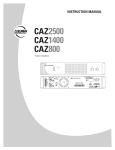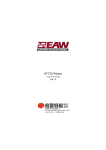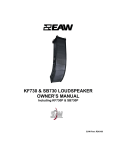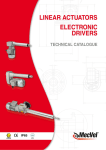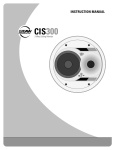Download EAW VRM12 Instruction manual
Transcript
VRM12 Two-Way, Full-Range Stage Monitor/PA INSTRUCTION MANUAL 1. SAFETY INSTRUCTIONS 1. 2. 3. 4. 5. 6. 7. 8. 9. 10. 11. 12. 13. The exclamation point within an Read these instructions. equilateral triangle is intended to alert the user of the presence of Keep these instructions. important operating and maintenance Heed all warnings. (servicing) instructions in the literature accompanying the apparatus. Follow all instructions. Do not use this apparatus near water. Clean only with a dry cloth. Do not block any ventilation openings. Install in accordance with the manufacturer’s instructions. Do not install near any heat sources such as radiators, heat registers, stoves, or other apparatus (including amplifiers) that produce heat. Only use attachments/accessories specified by the manufacturer. Refer all servicing to qualified service personnel. Servicing is required when the apparatus has been damaged in any way, such as liquid has been spilled or objects have fallen into the apparatus, the apparatus has been exposed to rain or moisture, does not operate normally, or has been dropped. The entire sound system must be designed in compliance with the current standards and laws regarding electrical systems. When installing and using this apparatus, keep in mind the technical specifications indicated in the dedicated section of the manual. Exposure to high sound levels can cause permanent hearing loss. The sound pressure level which leads to hearing loss varies considerably from one person to another, and depends on the duration of exposure. The U.S. Government’s Occupational Safety and Health Administration (OSHA) has established the maximum sound pressure levels that can be with stood without causing damage, which are shown in the table below. According to the OSHA regulations, any exposure over the maximum limits indicated in the table can reduce the hearing capacity of a person. To prevent potentially dangerous exposure to high sound pressure levels, anyone subjected to such levels must use suitable protection. When a EAW Commercial product capable of producing high sound levels is being used, it is therefore necessary to wear ear plugs or protective earphones when the limits shown in the table are exceeded. Consult the specifications provided in the instruction manual to know the maximum sound pressure (SPL) the loudspeaker is capable of producing. WARNING! This equipment has been designed to be installed by qualified professionals only! There are many factors to be considered when installing professional sound reinforcement systems, including mechanical and electrical considerations, as well as acoustic coverage and performance. EAW Commercial strongly recommends that this equipment be installed only by a professional sound installer or contractor. 2 – VRM12 Duration per day (hours) Sound level (dBA) Typical example Duo in a small club 8 90 6 92 4 95 3 97 2 100 1.5 102 1 105 0.5 110 0.25 or less 115 Subway train Very loud classical music Locomotive at 50 feet Loudest parts at a rock concert Part No. 0012178 Rev.A 10/04 © 2004 LOUD Technologies Inc. All Rights Reserved. 14. Rigging Precautions: When mounting or suspending EAW Commercial loudspeaker enclosures, it is essential that load ratings, rigging techniques, and special safety considerations be appropriate for the installation. Use only the mounting/rigging points on the loudspeaker enclosure intended for this purpose. The user must determine the load requirements, dynamic loading, and any other contributing factors affecting the loudspeaker installation. The user must determine the proper design factor for specific applications and the required load rating of the connection to structure. Comply with all applicable federal, state, and local regulations. EAW Commercial strongly recommends the following rigging system practices: • Documentation: Thoroughly document the mounting/rigging design with detailed drawings and parts lists. • Analysis: Have a licensed structural engineer or other qualified professional review and approve the mounting/rigging design before its implementation. • Installation: Use personnel experienced and qualified for mounting/rigging loudspeakers in accordance with and in compliance with all federal, state and local regulations. DANGER: Loudspeakers should be mounted or suspended only by persons with knowledge of the proper hardware and rigging techniques. When stacking or pole-mounting loudspeakers, be sure that they are stabilized and secured from falling over or being accidentally pushed over. Failure to follow these precautions may result in damage to the equipment, personal injury, or death. TABLE OF CONTENTS 1. SAFETY INSTRUCTIONS........................................................ 2 2. INTRODUCTION....................................................................... 4 3. INSTALLATION ........................................................................ 5 4. CONNECTIONS........................................................................ 6 5. OPERATION.............................................................................. 9 6. SPECIFICATIONS..................................................................... 10 Dimensions.............................................................................. 10 Performance Graphs .............................................................. 11 7. TROUBLESHOOTING .............................................................. 12 8. SERVICE and MAINTENANCE............................................... 13 9. WARRANTY ............................................................................. 15 VRM12 – 3 2. INTRODUCTION Congratulations on the purchase of your new EAW Commercial loudspeaker. You now own one of the finest professional audio products available – the result of exceptional engineering and meticulous craftsmanship. Please read these instructions to get the maximum performance from your new loudspeaker. Each EAW Commercial loudspeaker is intended for professional use. The construction, components, and hardware have been designed to provide robust, reliable performance for its intended application. Please ensure that you fully understand its proper installation and operation before use. This manual describes the VRM12 passive two-way stage monitor/PA. The VRM12 is engineered for superior performance as a floor monitor, and as a stand-mounted portable PA speaker. The low-profile, dual-angle enclosure houses a 12-inch coaxial driver that cuts through stage volume with high output capability. Coherent point-source reproduction helps deliver crisp speech for meetings and presentations, while the 12-inch LF driver delivers fullrange musical sound. The cross-ply laminated birch enclosure includes loop-thru Neutrik NL4 Speakon jacks on either side to minimize cable runs and clutter on stage. Rubber feet stabilize the enclosure on the floor. A pole-mount cup and integral handle are included for stand-mounting and transport. The VRM12 is available in either black or white finish. A foam-backed powder-coated steel grill protects the driver. Features: • Full-range, 2-way loudspeaker • Coaxial 12-inch woofer with 1-inch exit compression driver • Protection circuit for compression driver • Passive crossover for economical, single-amplifier operation • Enclosure has 30 degree and 45 degree wedge angles • Pole-mount cup allows pole mounting and use as a portable PA • Spring-loaded handle for ease of handling • Two Speakon jacks with input and through connections • Five-year warranty 4 – VRM12 Applications include: • • • • • • • TV studios Theaters Portable PA Classrooms Houses of Worship Audio-visual Presentations Performing Arts 3. INSTALLATION Unpacking and Inspection Visually inspect the outside of the shipping carton and check for any shipping damage. After unpacking, if you find concealed damage to the loudspeaker, save the packing materials for the carrier’s inspection, notify the carrier immediately, and file a shipping damage claim. Although EAW Commercial will help in any way possible, it is always the responsibility of the receiving party to file any shipping damage claim. The carrier will help prepare and file this claim. Mounting Precautions The loudspeaker is fitted with rubber feet for isolated positioning on stage. It can be mounted so the front grille face is tilted at 45 degrees, or at 30 degrees. The loudspeaker also has a pole-mount insert (1.5-inch diameter), allowing it to be polemounted for PA applications. WARNING: Installation should only be done by an experienced technician. Improper installation may result in damage to the equipment, injury or death. Make sure that the loudspeaker is installed in a stable and secure way in order to avoid any conditions that may be dangerous for persons or structures: • Check to make sure that the support surface (e.g., floor, etc.) has the necessary mechanical characteristics to support the weight of the loudspeaker and pole-mount without the danger of it falling. • When pole-mounting loudspeakers, be sure that they are stabilized and secured from falling over or being accidentally pushed over. Failure to follow these precautions may result in damage to the equipment, personal injury, or death. • Never use the handle for supporting or flying the loudspeaker. • Avoid installing the loudspeaker in places exposed to harsh weather conditions. VRM12 – 5 4. CONNECTIONS WARNING: To prevent the risk of electric shock, do not connect the loudspeaker with the amplifier switched on. The loudspeaker has two identical Speakon connectors, which are wired as follows: Inputs: • Pin 1+ is the positive (+) input, and connects to the positive (+) output of your power amplifier. VRM12 enclosure + Pin + + xover Pin 1+ 12+ 2- • Pin 1– is the negative (–) input, and connects to the negative (–) output of your power amplifier. 1+ 12+ 2- Speakon Speakon • Pin 1+ and 1– of one Speakon are connected internally to the VRM12 crossover’s input. They are also connected internally to Pin 1+ and 1– of the other Speakon, which can be used to send speaker-level power to another VRM12. Through Outputs: • Pin 2+ is the positive (+) through output. • Pin 2– is the negative (–) through output. • Pin 2+ and 2– are not connected internally to the VRM12 crossover’s input. They are only connected internally to Pin 2+ and 2– of the other Speakon. Connection Examples: • Using the second Speakon (Pin 1+,1-) to connect a second VRM12 in parallel. VRM12 enclosure 2-conductor cable + Amp A+ Pin 1+ 12+ 2- Speakon xover VRM12 enclosure + + + Pin Pin Speakon Speakon 1+ 12+ 2- 1+ 12+ 2- xover + + Pin 1+ 12+ 2- Speakon Make sure that the total average impedance of your loudspeakers does not drop below the recommended minimum load impedance of your power amplifier. For example, when two VRM12s are wired as shown above, the total average impedance is 4 ohm. For three VRM12s, the total average is 2.67 ohm. Make sure your amplifier can handle this load impedance, or it may become overloaded. 6 – VRM12 • Using the Pin 2+,2- Speakon connections to connect the second power amplifier channel to a subwoofer. VRM12 enclosure 4-conductor cable Amp A+ B+ + Pin xover + + Pin 1+ 12+ 2- 1+ 12+ 2- Speakon + Speakon Sub • Using the Pin 2+,2- Speakon connections to connect the second power amplifier channel to a second VRM12. You will need a cross-wired cable which has Pins 2 at one end connected to Pins 1 at the other. VRM12 enclosure 4-conductor cable Amp A+ B+ + Pin xover VRM12 enclosure cross-wired cable + + Pin Speakon Speakon 1+ 12+ 2- 1+ 12+ 2- Speakon + Pin xover + + Pin 1+ 12+ 2- 1+ 12+ 2- Lead Guitar (for example) Speakon Bass Guitar (for example) Loudspeaker Cables • Use loudspeaker cables with a minimum conductor size for the length you need, as listed in these tables. This will minimize Minimum AWG 4 ohm 8 ohm power losses to less than 0.5 dB. The cable lengths listed are “up to” lengths. 18 10 ft 25 ft For in-between lengths, use the next larger 16 25 50 conductor gauge. Using larger than the 14 25 75 recommended conductor size is always permissible. Using smaller than recommended 12 50 125 conductor size will result in higher power 10 100 200 losses. • The recommended conductor gauges are listed for AWG (American Wire Gauge) and Metric WG (Metric Wire Gauge). Note that smaller AWG numbers = larger conductors and smaller Metric WG numbers = smaller conductors. The Metric WG is equal to ten times the nominal conductor diameter in millimeters. Min Metric WG 4 ohm 8 ohm 12 3m 8m 14 8 15 16 8 25 20 15 40 25 30 60 • For cable lengths over 200 feet / 60 m at 8 ohms, and over 100 feet / 30 m at 4 ohms, the conductor sizes needed for less than 0.5 dB power losses are rarely practical for physical and cost reasons. As a practical compromise for these situations the recommended conductor gauge is 10 AWG or 25 metric. VRM12 – 7 Precautions • To prevent inductive phenomena causing humming or distortion, the speaker cables should not be run together with electrical energy conductors, microphone cables, or line-level audio lines. • Use speaker cables that have markings to distinguish the polarity, such as insulation or conductors of different colors. • Before using the loudspeaker, carefully check that all the connections have been made correctly to make sure there are no accidental short circuits that could cause electrical sparks. • Verify that the polarity of the connections to all of your loudspeakers is correct. When more than one loudspeaker reproduces the same frequencies, but with opposite polarity, there will be sound cancellations. Therefore, if any of the loudspeakers are wired so that the +/- connection polarity is reversed with respect to the others, incorrect reproduction will result. Most notably, the bass response will suffer. This is especially true when loudspeakers are situated in adjacent positions where the sound waves readily interact with each other. 8 – VRM12 5. OPERATION Signal Processing Sometimes external signal processing is desirable to “voice” the loudspeaker to accommodate particular program material, less than optimum acoustics, feedback control, or personal taste. For these purposes, use a suitable electronic signal processor. This can be as simple as a 1/3 octave graphic equalizer or a fully capable DSP (digital signal processor) such as the EAW Commercial DX810, or the EAW MX8750. Choosing a Power Amplifier There is no exact answer to the question of what amplifier size you should use for a loudspeaker. The loudspeaker power rating in EAW Commercial’s specifications only means it has passed a standard power test. This provides a rating that can be used as a point of comparison with other loudspeakers. This rating does not necessarily correspond to the best amplifier size to use nor is it a measure of a “safe” amplifier size to use. Rather, the amplifier should be sized according to both the sound levels required and the type of audio signals that will be reproduced. If you are unsure of how to determine this, consult with a qualified professional or contact EAW Commercial Technical Support. Preventing damage to the loudspeaker is a function of operating your audio system so that the loudspeaker is not stressed beyond its design limits. Operating Tips • Do NOT drive any of your electronic equipment into clipping, particularly the power amplifiers. This can easily damage the loudspeaker. • If driven into clipping, even an amplifier with a power output rating lower than the loudspeaker’s power rating can cause damage to a loudspeaker. • Avoid sustained microphone feedback. This can quickly cause failure of highfrequency drivers. • Avoid extreme boosts on equalizers as these can cause excessive input to the drivers at the boosted frequencies. Generally, cutting frequencies is preferred to adjust the frequency response. • With appropriate signal processing, your loudspeaker should produce exceptionally good sound. If it is used in a room with problematic acoustics, there is little you can do to overcome the room problems with electronic adjustments. Your best solution is careful placement and aiming of the loudspeaker so most of the sound is directed only at the audience. • Most EAW Commercial loudspeakers are capable of sound levels that can be damaging to human hearing. Take precautions so that audiences are not exposed to such levels. If you must expose yourself to these kinds of volume levels, wear adequate hearing protection. • Take care when moving or lifting the loudspeaker. Injury to you or damage to the loudspeaker can result from careless handling. VRM12 – 9 6. SPECIFICATIONS Model Woofer Woofer Loading Tweeter Tweeter Loading VRM12 12” x 1 Sealed 1” exit, Compression Horn Operating Range (–10 dB) 73 Hz – 20 kHz Horizontal Beamwidth - Nominal 90 degrees Vertical Beamwidth - Nominal 90 degrees Axial Sensitivity (whole space SPL) 94 dB, 73 Hz – 20 kHz Peak Sensitivity (whole space SPL) 97 dB, 20 Hz – 20 kHz Input Impedance - Nominal 8 ohm Input Impedance - Minimum 6.6 ohm @ 200 Hz Recommended High Pass Filter ≥ 60 Hz, 24 dB/octave Butterworth Power Handling 300 W, 49 V @ 8 ohms Maximum SPL, Average 119 dB Maximum SPL, Peak 125 dB Height (front face) Width (front face) Depth (from face, backwards) Dimension Tolerance Weight Pole Mount Diameter 15.00”/381 mm 15.00”/381 mm 12.50”/317.5 mm ± 0.1”/2.5 mm 36 lb/16.3 kg 1.5”/38.1 mm VRM12 Dimensions 15.00" (381.0) 5.94" (150.9) 3.94" (100.1) 12.50" (317.5) 15.00" (381.0) 7.50" (190.5) LEFT SIDE 0.44" (11.2 mm) FRONT 7.63" (193.7) RIGHT SIDE NOTES: 1. DIMENSIONS ARE IN INCHES, DIMENSIONS IN BRACKETS ARE MILLIMETERS 2. DIMENSION TOLERANCE ± 0.1" (2.5 MM) 10 – VRM12 De 10 PERFORMANCE GRAPHS Horizontal Vertical 1 100 1000 10k 20k (Hz) VRM12 ImpedanceFrequency vs Frequency Ohms 100 120 10 110 1 10 100 1000 10k 20k Frequency (Hz) dB SPL 100 90 80 70 60 10 VRM12 Axial Response vs Frequency 100 1000 10k 20k Frequency (Hz) VRM12 Beamwidth vs Frequency 120 360 110 Degrees SPL dB 100 90 80 100 10 Horizontal Vertical 70 60 1 10 100 1000 10k 100 20k 1000 10k 20k Frequency (Hz) Frequency (Hz) Disclaimer Ohms 100 10 EAW Commercial continually engages in research related to product improvement, new materials, and production methods. Design refinements are introduced into existing products 1 10 For this100 1000current EAW 10k 20k without notice as a routine expression of that philosophy. reason, any Frequency (Hz) Commercial product may differ in some respect from its published description, but will always equal or exceed the original design specifications unless otherwise stated. “EAW Commercial” is a trademark of LOUD Technologies Inc. All other brand names mentioned are trademarks or registered trademarks of their respective holders, and are hereby acknowledged. VRM12 – 11 7. TROUBLESHOOTING Loudspeaker difficulties usually fall into one of the following categories. The causes for each are listed in the most likely order of probability. No Sound or Low Output • Loudspeaker cables or connectors are not wired correctly or are faulty. Check all cabling, referring to these instructions for the correct connections. The best way to check a suspect cable is to swap it with a known good cable. Check the loudspeaker’s input panel to verify correct cable connections. • Electronic equipment is not turned on, or the level controls are not adjusted properly. Make sure that all equipment in the signal path is powered up, and that all controls are set to appropriate levels for normal operation. • Loudspeaker is not working. Connect the loudspeaker cable to a known good loudspeaker, leaving all equipment set to the same levels. If the problem disappears, the loudspeaker is probably not working. Contact EAW Commercial Technical Support for appropriate troubleshooting. Distorted Sound • The power amplifier is clipping. The signal level is exceeding the limits of your system and you must reduce the level. • Other electronic equipment is being overdriven. Ensure that no equipment in the signal chain is being over driven. For example: input(s) or summing bus in the mixing console, equalizers, etc. • Driver(s) not working properly. Contact EAW Commercial Technical Support for appropriate troubleshooting. Partial Sound (frequency band missing) • Incorrect EQ settings in the electronic equipment. Ensure that all EQ settings and filters on the mixing console, preamplifier, or other equipment are set for normal operation. Ensure that level controls on electronic crossovers and associated amplifiers are correctly set, and that all cables and connections for such equipment are connected and working properly. • Driver not working properly. Contact EAW Commercial Technical Support for appropriate troubleshooting. • The crossover network inside the loudspeaker is not working properly. Contact EAW Commercial Technical Support for appropriate troubleshooting. 12 – VRM12 8. SERVICE and MAINTENANCE Maintenance Usually, your EAW Commercial loudspeaker will not require regular maintenance for normal use. However, you can do several things to keep your loudspeaker in good operating and cosmetic condition. • Testing: Periodically test your loudspeaker for proper performance. A simple test is to play a CD through it using well-defined, articulate, wide-range program material. Listen to ensure all drivers are working properly and for any evidence of distortion or other extraneous sounds. Test at several volume levels: very low, normal, and high. • Mounting/Rigging: Any mounting or rigging hardware should be regularly inspected for security, wear, deformation, corrosion, and any other circumstances that may affect the load-handling capability. Immediately remove from service and replace any hardware whose load-handling capability may be compromised. • Cleaning: Cleaning the exterior of the enclosure will depend on the type of “dirt.” Dust, food spills, or similar contaminants can usually be removed with a cloth dampened with water, or a mild household cleaner. Avoid using any strong solvents as this may damage the finish. Turn the amplifiers off before cleaning. • Scratches or Dents in Wood Enclosures: Minor scratches on the enclosure can be painted over with an outdoor latex paint, or simply a colored in with a “Sharpie” or artist’s marking pen. More serious gouges or dents should be sanded out, filled with wood putty, and repainted. Touch-up paint in pints and quarts is available through EAW Commercial Technical Support. VRM12 – 13 Service If your loudspeaker should require servicing, please follow these instructions: 1. Call EAW Commercial Tech Support at 1-888-337-7404, 7 am to 5 pm PST (Monday-Friday), to verify the problem and obtain a Service Request Number. Be sure to have the serial number of the unit when you call. You must have a Service Request Number in order to obtain warranty service at the factory or at an authorized service center. You can also email EAW Commercial Tech Support at: [email protected] 2. Pack the unit in its original packaging. THIS IS VERY IMPORTANT. LOUD Technologies is not responsible for any damage that occurs during shipping due to nonconventional packaging. Original packaging helps to minimize the possibility of shipping damage. 3. Include a legible note stating your name, (no P.O. boxes), daytime phone number, Service Request Number, and a detailed description of the problem, including how we can duplicate it. 4. Write the Service Request Number in BIG BOLD PRINT on top of the box. 5. Tech Support will tell you where to ship the unit when you call for a Service Request Number. We suggest insurance for all forms of cartage. EAW Commercial Technical Support Phone (USA/Canada) 888-337-7404 Phone 425-892-6503 Fax 425-485-1152 Address One Main Street Whitinsville, MA 01588 Web site www.eawcommercial.com e-mail [email protected] 14 – VRM12 9. WARRANTY Warranty: LOUD Technologies Inc. requires its authorized EAW Commercial distributors abide by the following warranty terms for all EAW Commercial brand products (all dates are from the date of delivery from an Authorized EAW Commercial Distributor to the end user/installation site): Loudspeakers – 5 years; Active Electronics – 5 years; Accessories – 2 years. What Is Covered: Defects in workmanship and materials and against malfunctions. EAW Commercial distributors must remedy all such defects and malfunctions without charge for parts or labor if the warranty applies. Final determination of warranty coverage lies solely with each authorized EAW Commercial distributor. What Is Not Covered: This warranty does not extend to damage or malfunctions resulting from, but not limited to, shipment, improper installation, misuse, neglect, abuse, normal wear, accident, or to any product on which the serial number has been modified or removed. Exterior defects in or damage to the exterior appearance are specifically excluded from this warranty. EAW Commercial distributors shall not be liable for incidental or consequential damages resulting from the use of EAW Commercial products. Repairs and/or modifications by other than an Authorized EAW Commercial Distributor automatically voids this warranty. VRM12 – 15 EAW Commercial | One Main Street | Whitinsville, MA 01588 USA TEL toll free within US/Canada 888.337.7404 | TEL outside US 425.892.6503 | FAX 425.485.1152 www.eawcommercial.com © 2004 LOUD Technologies Inc. All Rights Reserved. EAW Commercial is a registered trademark of LOUD Technologies Inc.



















